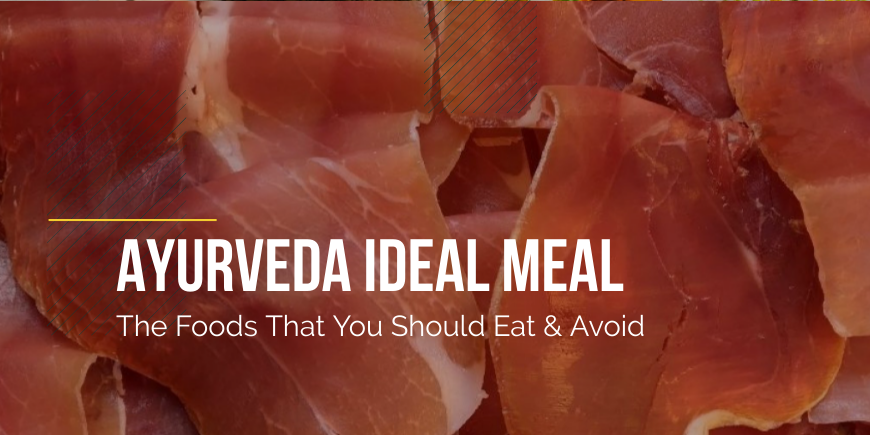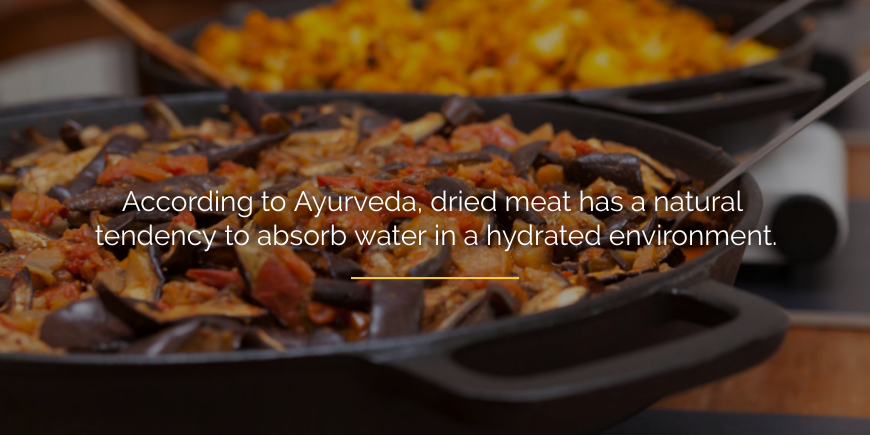
Introduction
Ayurveda categorizes all substances into three main categories –
Dosha prashaman – the substances that create dosha balance in the body
Dhatu pradoshanam – the substances that pollute the body tissues (dhatus – digested juice, blood, muscles, fatty tissue, bones, marrows, and reproductive tissue).
Swasthyavritta – the substances that preserve health.
The following shloka from Charak samhita describes the second category of substances – foods that can pollute the body tissues.
वल्लूरं शुष्कशाकानि शालूकानि बिसानि च| नाभ्यसेद्गौरवान्मांसं कृशं नैवोपयोजयेत्||१०||
Charak samhita, Sutra Sthana, Chap-5/11
It is more important to know about harmful foods than healthy food. Because harmful food items are fewer in number. But their consumption can bring disease and distress. Therefore, Acharya Charak tells about “what to avoid”, before “what to eat.”
Matrashatiya adhyaya (Chapter -5, Sutrasthana) the chapter that deals with the ideal Ayurvedic daily routine in Charak samhita describes a group of food items that are not good for health. The sutra does not lay a complete prohibition on eating these foods. It uses an interesting term – abhyas (practice). Therefore, occasional consumption of these foods is fine. However, no health-conscious person should consume this prohibited food frequently.
Let us see what are these prohibited foods and why you should avoid them.
Summary
According to Ayurveda, some things are good to eat and some are not. Ideal Ayurvedic meal guidelines in Charak samhita prohibit some special food items for regular consumption. Dried meat is the first one of them.
Dried Meat
The word “Vallur” refers to dried meat. Charak samhita prohibits the frequent use of dried meat. And there can be multiple reasons for this prohibition.
Dried Meat – The Ayurveda Angle
According to Ayurveda, dried meat has a natural tendency to absorb water in a hydrated environment. It absorbs water inside the body and swells to its original constitution. However, this water absorption by dried meat may disturb the water balance in the body fluids.
In this manner, the dried meat transfers its dryness to the body. Dryness is an integral property of the vata dosha. Therefore, this dryness has the potential to vitiate vata dosha. Ayurveda says that vata is the most powerful of the three biophysical energies that run our bodies. It governs both the nervous and hormonal systems to a large extent. Constant consumption of dried meat may lead to incremental vata vitiation. This exponential growth in vata vitiation may result in severe disorders.
Vata dosha also leads to deterioration. Here, we can understand deterioration in terms of the increase in free radicals in the body. Increased number of free radicals leads to rapid cell damage and death. For example, dryness and shriveling away of the nervous sheath leads to rapid deterioration and early death in nerve cells.

Summary
Dried meat absorbs body moisture and incidentally makes the body dry. This dryness can vitiate vata dosha and trigger severe disorders.
Besides, it is heavy and may produce digestive toxins.
Dried Meat Related Health Hazards
Small size beetles Dermestes lardarius L., D. maculatus Degeer normally infest dried meat and lay eggs on it. There are many other insects, mites, and pathogens that may thrive on dried meat, esp. if it is not properly preserved.
Besides, dried meat is also a likely source of Clostridium botulinum contamination. It may lead to botulism or food poisoning. The word botulism emerged from the term “Wurstvergiftung,” (German term for sausage poisoning).
A few centuries back, the normal dried meat was either sun- or air-dried. People used salt and sugar for meat preservation. However, some people also use saltpeter or salts of nitrate for curing and drying meat. Nitrates and Nitrites are harmful to the body in large quantities. Multiple scientific studies found a direct association between nitrates/nitrites and stomach cancer. This is another reason dried meat is even more harmful than earlier.
Summary
Dried meat is an ideal incubation point for multiple insects and microbes like Clostridium. It may cause digestive disorders and even food poisoning. Nitrates and nitrites present in cured meat are directly associated with stomach cancer.
Healthy Usage of Dried Meat
Chinese Cuisine – Bakkwa
Dried meat is not great for the body. However, people in many cultures frequently use dried meat preserves, esp. in extreme climatic conditions. For example – For centuries, Chinese cuisine has used Rougan or Bakkwa. Rougan is a Chinese salty-sweet dried meat. It uses pork, mutton, or beef as a base, along with sugar, salt, spices, and soy sauce as natural preservatives.
Chinese people have used it throughout their lives and do not seem to face any severe problems. But it is important to note Karan or the usage method of dried meat.
Chinese custom recommends the use of Bakkwa esp. During Chinese New Year. It was not eaten throughout the year. Chinese new year normally falls in Feb. This time of the year brings frigid climatic conditions. Earlier, it must have been difficult to find vegetables or fruits during this time. Therefore, people relied on dried or preserved food items to survive the extreme winters. The extensive use of natural preservatives like vinegar, soya sauce, etc. in Chinese cuisine also reflects the same logic.
Also, agni or the digestive fire during the winter (Hemant: Jan-Feb) is at its best. All doshas are in a cyclic state of balance at this time of the year. Therefore, the body can digest and absorb heavy food like dried meat.
South Indian Cuisine – Uppukandam
Uppukandam is dried and spied mutton from the South Indian state of Tamil Nadu. However, Uppukandam is later fried or boiled, used in sambhar where it loses its dryness. The oil used in the cooking process also helps to reduce its drying impact.
Mongolian Cuisine – Borts
Borts is another type of powdered dried meat. It is mainly prepared from horse meat and extensively used in the harsh climatic conditions of Mongolia. However, upyogsanstha or the usage makes it healthy and nutritious. The traveling Mongolians would take a pinch of bort powder, mix it in water and boil it to make a soup. This soup with a pinch of bort would serve 3-4 people!
Therefore, bort usage has two beneficial points. Firstly, boiling eliminates the dryness. Secondly, it is easy and nutritious to digest a very small amount of boiled and diluted meat powder.
Summary
Different cultures have used dried meat as survival forage in extreme climatic conditions. However, these traditional preparations use dried meat in a healthy manner and at an appropriate time. For example, the Chinese use dried meat Bakkwa during extremely cold climates and in small quantities.
Dried meat ensures food security and survival in extreme conditions. And it is healthy if you use it very rarely.
Take Away
The bottom line is – Charak samhita prohibits the frequent use of dried meat. Still, dried meat can serve as a raw material for wet/oily recipes. It is not healthy to consume dried meat directly.
Also, sometimes it is imperative to consume dried meat due to climatic or environmental constraints. But you must try to avoid its consumption if you have better food options.
Are you ready to explore the ancient healing system of Ayurveda? Our Ayurveda Certification Course offers a comprehensive understanding of this time-tested practice. From learning the fundamentals to advanced techniques, you’ll gain the knowledge and skills to promote optimal health and well-being. Join us on this transformative journey and become a certified.
Responses